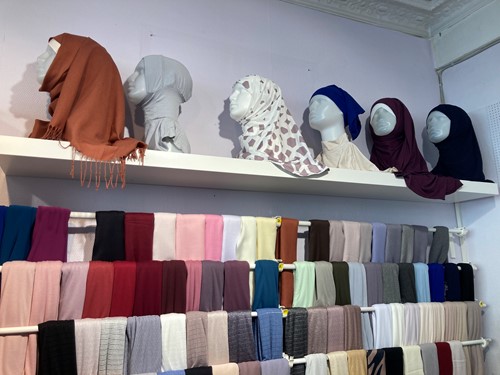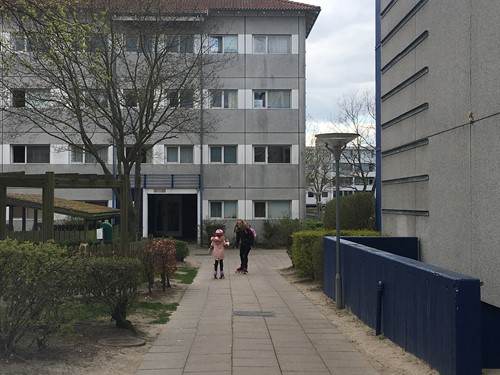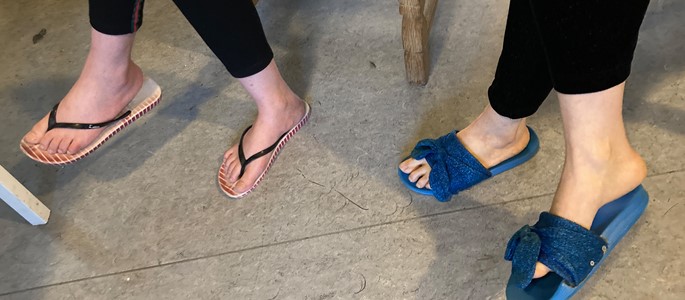Equal treatment discriminates a certain group of women
Blindness to gender aspects keeps women dependent and vulnerable in the asylum system and the integration process
This text was brought in the Danish newspaper Politiken 1. September 2023. The report can be downloaded in PDF format in English or Danish, or ordered as a printed book in Danish.
Men and women are treated equally when they arrive in Denmark and apply for asylum or come here as family members. The asylum centres are mixed, and everyone goes through the same process concerning need of protection or attachment to Denmark. Danish language education and job training in the municipalities are mandatory for both men and women.
In Denmark, we have a policy of gender equality, and we perceive special treatment and division into genders as something negative and old-fashioned. But equal treatment does not lead to equality. If you want to treat all people the same, they must have the same starting point. Otherwise, it can actually lead to discrimination. A good illustration is the image of a teacher who says: "To ensure a fair selection, you will all be given the same exam task: you must climb the tree!" But his students are different animals such as a monkey, a wolf, a hedgehog and a squirrel - for some the task will be easy, for others impossible.
"Discrimination can be defined as unreasonable differential treatment which leads to a person receiving worse treatment or protection than others. (…) It is not illegal to treat people differently. On the contrary, that is often necessary to ensure that everyone is treated equally.” This is what the Danish Institute for Human Rights writes on its website.
In Refugees Welcome, we have just published the report "They don't know how much stress we have", which describes how thousands of women are exposed to discrimination by Danish society – not deliberately, but because it is ignored how different their starting point is, compared to their husbands and brothers, and compared to Danish women. On many points, women have a much poorer chance of living up to the demands they meet, even though they are often strong women who put up a good fight.
Asha was not allowed to go to school in her native Somalia. Therefore, she has been enrolled in language education Dansk 1, and she will never be able to pass Dansk 2, which is a requirement to obtain permanent residence, or Dansk 3, which is required to obtain Danish citizenship. A demand that her brothers would have some chance of living up to. This is structural discrimination. Nevertheless, as a single mother and after spending the first 6 years in an asylum centre, she has brought up 6 children, who today have all completed higher or vocational education.
We let the women speak for themselves through 19 case stories and lots of quotes, for example Samira, who is Palestinian and now lives in a deportation centre because she left a violent husband: "I came to Denmark four years ago because I got married. But he beat me, and I left him after four months. I cannot travel back to Lebanon where my family lives. They want to kill me because I'm divorced. Now I've been in Kærshovedgård for a year, and I can't get money or help from anyone. It's very hard."

The report is about women and girls who, for various reasons, cannot be in their home country, and are now staying in Denmark, with or without permission. We have not included women who came as migrant workers or because of marriage to an ethnic Danish man. Some have left their home country alone, others with family members. Some have arrived after a perilous journey with the help of people smugglers to apply for asylum, others have been waiting for permission to be reunited with a husband or father who traveled ahead and was granted asylum. Still others have been lured here with false promises but have ended up in abusive marriages.
These women fall within the following categories:
• asylum seekers,
• recognized refugees,
• displaced persons from Ukraine,
• family reunified with refugees,
• undocumented, e.g. after refusal of asylum,
• trafficked.
Many of these women also fall under the category of "non-Western", but this is a Danish definition which both the UN and the EU describe as stigmatizing and inappropriate, and therefore we have not used it in the report. The majority of the women in the above categories come from countries in the Middle East and Africa, but also from e.g. Ukraine, Bosnia, Sri Lanka and Thailand.
The women, who to a large extent speak for themselves in the report, often have an intersectional vulnerability in Danish society, which leaves them at the bottom of the hierarchy. Eg. Binta from Gambia: she is not only a woman, but also a lesbian, illiterate, black, Muslim, poor and a rejected asylum seeker.
"No one understands how we feel. They don't know how much stress we have. If you've never experienced being forced to do things against your will, so you really feel vulnerable, then you can't judge." This is what Estella from Uganda says, after spending 5 years at a deportation centre with her young son. She is a victim of human trafficking.
These women are not a homogeneous group, and it is important to be aware of the great risk of generalizing and falling into stereotypes. Unfortunately, the Danish system finds it difficult to cope with their differences. The individual woman also contains a duality: she is, for example, a vulnerable victim of violence, made dependent on others, but at the same time a tough and strong woman who takes on a great responsibility and stubbornly works towards a goal of independence, despite her bad odds.
Many legal measures have been introduced regarding ethnic minority women in Denmark in order to get them into the labour market and reduce their isolation at home. Today, there is a great focus on stopping oppressive cultures and patterns from their home countries, i.e. forced and arranged marriages and negative social control in general. Unfortunately, the tools have often been limited to heavy-handed sanctions, which risk placing further burdens on the women they claim to help.
In 2015, Jamila had her residence permit revoked, although she explained that the divorce was due to violence, and she had lived in a women’s shelter for three months. She had explained how she had stayed with the man for fear of losing her residence permit. Her job centre confirmed that she had told about the violence. But there was no documentation of visible marks after the violence or medical records. The authorities did not believe that the violence was necessarily the reason for the break-up. Furthermore, it was emphasized that Jamila had retained a strong attachment to her home country, and the fact that she had started the SOSU assistant training was not sufficient on the integration side.
Politicians as well as the public debate have completely overlooked the role that the Danish system itself plays in maintaining some of these women in oppression and dependence on their husbands.
To support that claim, we must start by looking at what the women in question carry in their luggage when they arrive in Denmark – and this applies to both their upbringing and the experiences they have had on the journey. Afghanistan, Somalia and Iran directly oppress women and girls in legislation, whereas countries such as Iraq, Syria, Eritrea and Myanmar formally grant women rights but in practice do not in any way give them equal opportunities.
In general, women in the mentioned categories have poorer prerequisites for doing well in Danish society due to the conditions under which they grew up. It starts in the asylum centres, in the asylum process and in the asylum assessments, where women are clearly disadvantaged compared to men. In the asylum centres the women are a minority and feel unsafe among the many single men. Women are less equipped to go through the long interviews, and women's asylum motives trigger a much weaker legal status than men's, and it can be revoked again much easier. Many women get asylum because of their husband's case and are thus bound to him.
A single African woman says: "I had to bring my baby with me to all the interviews. He was two years old. He sat on my lap and then they gave him an iPad and headphones so he could watch cartoons. But he couldn't look at it for so many hours, he was crying and running around. It was absolutely impossible for me to concentrate."
However, approximately 80% of the women arrive through family reunification, and thus do not have their own grounds for a residence permit at all but are completely dependent on their husband – and risk losing it if the cohabitation ends.
The women's background makes it difficult for them to live up to the demands from Danish society. They have attended less school and have less education than their brothers and husbands. This means that more women than men are enrolled in the lowest level of Danish language education, from which a passed exam does not give access to either further education, permanent residence or citizenship.
The majority have been exposed to violence from those closest to them at some point, and many have not been allowed to make independent decisions about their own lives. There are many single mothers in the group, and even in families with a father, the mother almost always has primary responsibility for the children, which ties them to the asylum centres or to the home.
They also had less relevant work experience and had less independent income in their home country, which puts them at a disadvantage in relation to entering the Danish labour market. Case workers in the job centres suffer from prejudices that women do not want to work and offer them fewer and inferior types of jobs than men. The changing versions of low start-up benefits for refugees have had no effect on getting more women into work, and only a limited effect for men. The reduced benefits hit single mothers particularly hard, according to the Danish Institute for Human Rights.
These women find it difficult to enter the labour market, and when they succeed, they get a lower salary, a smaller pension, especially due to maternity leave – just like Danish women, by the way. However, they often end up at the very bottom of the hierarchy, and their health is far worse than that of Danish women. By the time they reach retirement age, 20-25% of women from the Middle East and Turkey live below the now-abolished poverty line, which only applies to 10-15% of their husbands and only 1% of ethnic Danish men and women.
In the area of education, you see something surprising: fewer of the women in this group have an education with them from their home country, yet twice as many women as men take an education in Denmark. The same trend can be seen among the young and the descendants, where the girls overtake not just their brothers but also the ethnically Danish girls. It shows that women have a great desire to improve their skills and support themselves. For this reason, both Sweden and Norway have far more success in getting women from for example Syria into work – because our neighbouring countries work on a long-term strategy based on upskilling rather than the Danish quick-fix of finding unskilled jobs as soon as possible.
Although we are sinking further and further down the world rankings on the measurable indicators, Denmark has a self-image of having achieved almost total equality between the sexes. We are currently in 29th place, while all our Nordic neighbouring countries are stable in the top five. Even ethnically Danish women have thus far from achieved equality, despite our equal access to school, and our free choice of job, marriage, etc.
When the mentioned group of women in Denmark have even worse conditions and are kept in dependency on their husbands, it is not because Danish society has a desire to put them at a disadvantage. It is merely a result of not paying attention to the gender aspects and not bothering to organize efforts and demands in such a way that these women have a real chance to take advantage of them and live up to them.

The report contains 12 recommendations for improvements, both in the asylum procedure, the integration phase and the final goal of becoming a Danish citizen.
• More safe access routes to Denmark are needed.
• There is a need to focus more on the safety of women and girls in the asylum centres.
• Women's and men's asylum motives have to be considered equally.
• More screening, support and treatment of victims of violence is needed, and certain forms of sexual violence should be equated with torture.
• We must make sure that no woman stays with a man against her will in order to keep her residence permit.
• Danish language education must be adapted better to women, and women need better access to upgrade their qualifications to enter the labour market.
• Increased focus on women's health is needed.
• Requirements for permanent residence and citizenship should be adjusted according to the individual's starting point and opportunities.
• New arrivals of both sexes need to be taught about rights and equality.
• And there is a need for structured collaborations with Muslim organizations to offer support to Muslim women and girls who have problems.
It is time for Denmark to do some self-examination when it comes to women who have sought refuge in this country and who have not had as privileged a life as us. Their own husbands are not the only problem. They don't want to be isolated housewives, but they also don’t benefit from working 37 hours per week as an unpaid intern in a warehouse, or to live under a threat of losing their residence permit if they get divorced. These women call for information, relevant offers and support to make their everyday life work, then they are happy to make a huge effort and they will welcome with joy and pride the opportunities they did not have in their country of birth.
Sharareh is a trained journalist from Iran, where she was imprisoned and tortured. She came to Denmark with her 16-year-old daughter but had to spend 10 years in the asylum centres before she finally managed to get the case reopened and get asylum. She gets the last word: "It was not Iran that prevented my daughter from developing into an independent woman. It was the Danish asylum system that prevented her from doing so."
__________
If you wish to contact the author for an interview or a presentation, please use the e-mail: kontakt(at)refugees.dk
Our reports and other efforts
are only possible due to support
from our private donors & members!


